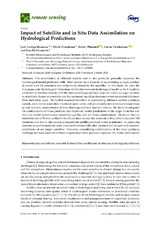Impact of Satellite and in Situ Data Assimilation on Hydrological Predictions
Autor
Musuuza, Jude Lubega
Gustafsson, David
Pimentel, Rafael
Crochemore, Louise
Pechlivanidis, Ilias
Editor
MDPIFecha
2020Materia
Data assimilationEnsemble Kalman filter
Satellite data
In situ data
Hydrological predictions
METS:
Mostrar el registro METSPREMIS:
Mostrar el registro PREMISMetadatos
Mostrar el registro completo del ítemResumen
The assimilation of different satellite and in situ products generally improves the hydrological model predictive skill. Most studies have focused on assimilating a single product at a time with the ensemble size subjectively chosen by the modeller. In this study, we used the European-scale Hydrological Predictions for the Environment hydrological model in the Umeälven catchment in northern Sweden with the stream discharge and local reservoir inflow as target variables to objectively choose an ensemble size that optimised model performance when the ensemble Kalman filter method is used. We further assessed the effect of assimilating different satellite products; namely, snow water equivalent, fractional snow cover, and actual and potential evapotranspiration, as well as in situ measurements of river discharge and local reservoir inflows. We finally investigated the combinations of those products that improved model predictions of the target variables and how the model performance varied through the year for those combinations. We found that an ensemble size of 50 was sufficient for all products except the reservoir inflow, which required 100 members and that in situ products outperform satellite products when assimilated. In particular, potential evapotranspiration alone or as combinations with other products did not generally improve predictions of our target variables. However, assimilating combinations of the snow products, discharge and local reservoir without evapotranspiration products improved the model performance.

